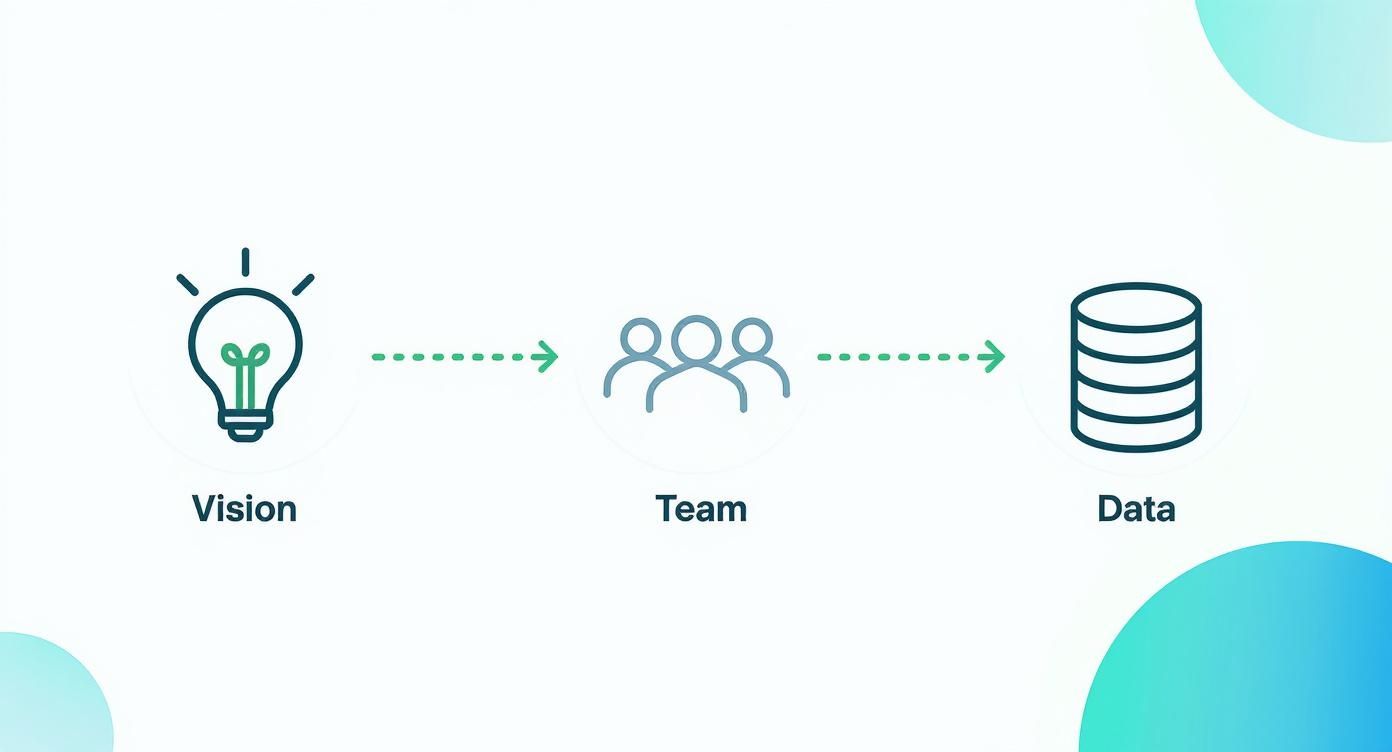How to Implement AI in Healthcare Organizations: A Quick-Start Guide
Bringing AI into a healthcare setting isn’t just a tech project; it’s a fundamental shift in strategy that has to start with a clear vision, the right people in the room, and a serious look at your data. To get anywhere, you first need to define what success actually looks like, maybe it’s cutting down on diagnostic errors or streamlining how patients move through your facility. From there, you build a business case that shows real value, both in terms of dollars and patient outcomes. Getting this groundwork right is everything; it sets the stage for the entire journey.
Building Your AI Foundation in Healthcare
Kicking off an AI initiative is so much more than buying a new piece of software. It’s about rethinking how you deliver care and manage your operations from the ground up. The absolute first move is to create a compelling vision that everyone, from the C-suite to the clinicians on the floor, can get behind.
What’s the end goal? Are you aiming for a 15% reduction in diagnostic errors by using AI to analyze medical images? Or is the focus on optimizing patient flow to slash wait times and boost satisfaction scores? Your business case needs to spell this out, connecting the dots between the technology, the financial ROI, and real, tangible improvements in care.
This is also when you have to be brutally honest about your data. Quality, accessible, and well-structured data is the fuel for any AI model. Without it, the most sophisticated algorithm in the world is useless.
Assembling Your Cross-Functional Team
AI implementation is a team sport, plain and simple. You need a cross-functional group from day one to make sure every angle is covered and to avoid blind spots.
Your core team should have people from:
- IT and Data Science: These are your tech gurus who will handle the infrastructure, data pipelines, and the AI models themselves.
- Clinical Staff: You absolutely need physicians, nurses, and technicians involved. They’re the end-users and can tell you exactly how a new tool will fit—or not fit—into their daily workflows.
- Legal and Compliance: This group is critical for navigating the maze of regulations. Staying on the right side of the law is non-negotiable, and a thorough HIPAA compliance requirements checklist is an essential tool from the very beginning.
- Operations and Administration: They ensure the AI strategy aligns with the hospital’s larger goals and keep an eye on the budget.
The Unstoppable Momentum of Healthcare AI
This isn’t some far-off trend anymore. The push for AI in healthcare is happening right now, and it’s picking up speed fast. We’re seeing a massive acceleration, with 63% of healthcare organizations already using AI in some capacity and another 31% running pilots or evaluating new projects. This puts healthcare way ahead of many other industries when it comes to enterprise AI.
And the results are speaking for themselves. A staggering 81% of healthcare professionals say AI has already helped increase revenue. Even better, nearly half of them saw a return on their investment in the first year.
This visual gives you a good look at the core pillars for setting up your AI foundation, from creating the vision to getting your data and team ready.

As the infographic shows, all these foundational pieces are connected. You have to work on them together to build a solid platform for what comes next. It’s a complex process, and frankly, it’s often best to bring in an experienced partner who has been down this road before. The right guide can help you build a solid business case, assess your data readiness, and assemble a team that’s truly set up to win.
Selecting Your First High-Impact AI Project
The secret to getting AI off the ground in any healthcare setting is to score a quick, undeniable win. It’s tempting to dream big and plan a massive overhaul of your entire system, but that’s a recipe for getting bogged down. Instead, your first move should be a focused pilot project that solves a real, nagging problem for your staff or patients.
Think about areas where you can see a direct, measurable impact. For instance, an AI model that predicts patient no-shows can almost immediately improve scheduling and cut revenue loss. That’s a win you can take straight to the finance department. Another great starting point? Tackling the soul-crushing prior authorization process. Automating even a piece of that can free up staff and reduce a major source of administrative burnout.
As we explored in our AI adoption guide, this first project sets the stage for everything that follows. A successful pilot builds trust and generates the kind of buzz you need to get stakeholders excited about more ambitious AI initiatives down the road.
Finding the Sweet Spot for Your First Project
The ideal first project lives at the intersection of high impact and genuine feasibility. It’s less about the flashiest technology and more about delivering tangible value without a multi-year development cycle.
To find that sweet spot, you need to ask a few tough questions:
- Real-World Impact: Will this meaningfully improve patient care, make a clinician’s day easier, or trim operational waste?
- Technical Reality Check: Do we actually have the data, infrastructure, and skills to pull this off? Is the project’s scope tight and manageable?
- Data Readiness: Can we get our hands on the necessary data? Is it clean enough to be useful, or will we spend a year just trying to make sense of it?
- Measuring Success: How will we know if it worked? We need clear, simple KPIs to prove the project was a success.
Walking through these questions helps you avoid the common trap of chasing a project that’s just too big or complex for a first attempt. This is where an expert-led AI discovery workshop can be a game-changer, helping your team cut through the noise and identify a use case with a high probability of success.
Getting Your Data House in Order
Once you’ve picked your target, the conversation immediately turns to data. Let’s be honest: healthcare data is a mess. It’s fragmented, siloed, and locked away in EHRs, PACS systems, lab reports, and billing platforms that don’t play nicely together.
The first real work is pulling all those disparate sources into a single, cohesive view. This is a heavy lift, often requiring specialized business intelligence services to create a reliable foundation for any AI model you hope to build.
The bottom line is this: Your AI is only as smart as the data you feed it. Time spent on data cleansing, integration, and governance isn’t a “nice-to-have”—it’s a non-negotiable prerequisite for building any AI tool that you’d trust in a clinical or operational setting.
And, of course, every single step has to be wrapped in iron-clad HIPAA compliance and patient privacy protocols. De-identifying and securing data is paramount. This is precisely why many hospitals and health systems choose to work with a healthcare software development partner who lives and breathes this stuff. They bring the niche expertise needed to navigate the complexities of health data and build a secure, scalable data backbone that will support you for years to come.
To help you start this evaluation, here’s a simple framework for weighing potential projects.
Prioritizing AI Use Cases in Healthcare
This table offers a way to compare potential AI projects, balancing their potential upside against the practical challenges of implementation.
| Use Case Area | Potential Impact | Technical Feasibility | Data Requirements | Example Application |
|---|---|---|---|---|
| Administrative Automation | High | High | Structured (Billing codes, schedules) | AI-powered prior authorization submissions |
| Clinical Decision Support | Very High | Medium | Complex (EHR notes, imaging data) | Predicting sepsis risk in ICU patients |
| Patient Engagement | Medium | High | Structured (Appointment history, demographics) | Forecasting patient no-show likelihood |
| Operational Efficiency | High | Medium | Mixed (Staff schedules, bed occupancy) | Optimizing operating room scheduling |
Looking at a simple breakdown like this makes it clearer where your best opportunities lie. A high-impact, high-feasibility project like automating prior authorizations is often a perfect place to start building momentum.
Choosing Your Technology and Development Path
Once you’ve locked in your project’s vision, you’ll hit a major fork in the road: should you build your own AI solution, buy an off-the-shelf product, or find a partner to work with? This isn’t a small decision. It fundamentally shapes how your AI initiative will unfold, and the right answer really comes down to your team’s expertise, budget, and long-term strategy.
Build, Buy, or Partner? Weighing Your Options
Building from scratch gives you ultimate control. You can tailor every last feature to your unique clinical workflows and data. That’s the dream, right? But the reality is that this path is incredibly resource-intensive. It demands a sophisticated in-house data science team and a hefty budget, which is a luxury most healthcare organizations just don’t have.
Buying a ready-made product seems like the quick and easy way in. It can certainly get you up and running faster, but be careful. These one-size-fits-all solutions often clash with the messy, complex realities of a hospital environment. A tool that creates friction and doesn’t fit naturally into a clinician’s day is a tool that won’t get used.
This is why, for many, a strategic partnership hits the sweet spot.
The Power of the Right Partnership
Partnering gives you the best of both worlds—it’s faster than building from the ground up but far more customized than a generic off-the-shelf tool. When you find the right AI solutions partner, you’re not just hiring coders; you’re bringing in a team with deep, proven experience in both healthcare and AI.
A good partner offers comprehensive AI development services and understands the nuances of the clinical world. They’ll help you make critical tech decisions, like whether to go with an on-premise setup for total data control or use scalable cloud services for more flexibility.
A partnership isn’t just about outsourcing the work. It’s about importing specialized expertise. The right collaborator will challenge your assumptions, guide your strategy, and ensure the final product is not only technically sound but also clinically valuable and readily adoptable.
Vetting the Tech and Nailing Compliance
No matter which path you take—build, buy, or partner—the technical due diligence has to be relentless. Any solution you consider needs to be put through its paces to ensure it meets your organization’s demanding standards for security, compliance, and interoperability. It absolutely must integrate smoothly with your EHR and other core systems while upholding every letter of HIPAA law.
It’s also crucial to recognize that context matters. AI adoption looks very different depending on the size and location of a hospital. Large hospitals with over 400 beds are way ahead, with adoption rates hovering around 90-96%. Compare that to smaller hospitals (under 100 beds), where the rate is much lower at 53-59%. We see a similar gap between urban hospitals (77-81%) and their rural counterparts (48-56%).
What does this tell us? That a one-size-fits-all implementation strategy is doomed to fail. Your approach has to be tailored to your specific resources and environment.
Ultimately, whether you build, buy, or partner, the goal remains the same: choose technology that solves a real problem today while strengthening your foundation for whatever comes next. Making a thoughtful, strategic choice here is what separates the successful AI projects from the ones that never get off the ground.
Weaving AI into the Fabric of Clinical Workflows
An AI tool is only as good as its adoption. You can have the most brilliant algorithm on the planet, but if clinicians find it clunky, don’t trust its recommendations, or see it as just another box to check, it’s worthless. The real win is when the technology feels invisible—a natural part of a clinician’s thought process, not some frustrating new task.

Getting this right demands a deep partnership between the people building the tool and the people who will actually use it—your doctors, nurses, and technicians. Before you even think about finalizing the code, you have to get out on the floor. Shadowing users and conducting detailed interviews aren’t just nice-to-haves; they’re essential for understanding the messy reality of how work gets done.
The entire point is to serve up critical insights right when and where they’re needed, without disrupting the rhythm of a patient encounter. This focus on human-centered design is what makes or breaks an AI project. For instance, an MDT planning app we developed succeeded because it was built shoulder-to-shoulder with medical professionals, ensuring it simplified their complex planning, rather than adding to it.
Getting People on Board with Smart Change Management
Beyond just the tech, you need a solid change management plan. You can’t just launch a new AI tool and hope for the best. True success hangs on whether your clinical and administrative teams actually embrace it, which means you have to be proactive about overcoming user adoption barriers.
Talk to your staff—early and often—about why this change is happening. Frame it around what’s in it for them and their patients. Will it slash their paperwork? Give them faster access to key data? Offer a second set of “eyes” on complex diagnostics? Those are the benefits that resonate.
This also means offering comprehensive, hands-on training and having support readily available. You need to build confidence and tackle skepticism head-on. And don’t forget the power of your internal champions. A respected doctor who is an early adopter can do more to convince their skeptical colleagues than any top-down mandate ever could.
Remember, you’re not just installing software; you’re fundamentally changing how people work. That takes empathy, education, and consistent reinforcement. Acknowledge that there’s a learning curve and foster an environment where people feel safe asking questions and giving honest feedback.
Use Early Wins to Build Momentum
One of the best ways to get the whole organization excited is to show off the concrete wins from your pilot program. When other departments see real, positive results, you’ll notice the skepticism starts to melt away, replaced by genuine curiosity.
Make sure you document and share these successes far and wide:
- The Hard Numbers: Point to metrics like a 20% reduction in patient wait times or a 15% boost in scheduling efficiency. Highlighting how much administrative time was saved is always a powerful argument.
- The Human Element: Collect testimonials from clinicians who genuinely love the tool. A single quote from a trusted physician about how the AI helped them catch something early can be more powerful than any spreadsheet.
- The Patient Impact: Always bring it back to the patient. Showing how a new tool led to a better diagnosis or a smoother care journey is the ultimate proof of value in any healthcare setting.
These early victories create a ripple effect. They turn a single project’s success into unstoppable organizational momentum, providing the social proof you need to secure more funding and scale your AI initiatives across the entire organization.
Scaling and Governing AI for Long-Term Success
Getting a pilot project off the ground is a fantastic start, but it’s really just the first step. The true power of AI in healthcare comes when you move beyond those initial, isolated wins and start embedding it across the entire organization. This is where responsible scaling comes in, shifting your focus from managing a single project to building a durable governance framework for the long haul.

This transition is all about creating systems to manage the AI lifecycle from idea to retirement. Let’s be clear: without a strong governance structure, scaling can introduce huge risks—think inconsistent model performance, biased clinical recommendations, or even serious compliance violations. It’s about putting up guardrails that allow innovation to flourish while keeping patients and the organization safe.
Putting Robust AI Governance in Place
The first thing you have to do when scaling is to formalize oversight. This isn’t about creating red tape; it’s about building accountability and ensuring every AI tool aligns with your ethical standards as its influence grows. A cornerstone of this is an AI ethics committee.
This can’t be a siloed group. You need a mix of people at the table: clinicians, data scientists, legal counsel, and patient advocates. Their job is to get ahead of problems by reviewing AI projects before they’re deployed, tackling potential issues around fairness, bias, and transparency head-on. They are the ones who will define what “responsible AI” looks like in your hospital or health system.
Beyond the committee, you absolutely need clear, written policies for ongoing model monitoring. AI models are not “set it and forget it.” Their performance can drift over time as patient demographics shift or clinical protocols evolve. Regular audits are non-negotiable to ensure the models stay accurate, reliable, and safe for clinical use.
Governance is the essential bridge between a successful AI pilot and a sustainable, organization-wide AI strategy. It transforms your initial momentum into a controlled, ethical, and effective expansion that builds trust among both clinicians and patients.
Expanding Your Technical Backbone
As your AI ambitions grow, your infrastructure has to grow with them. The setup that worked for a single, contained pilot will quickly become a bottleneck when you’re trying to support multiple complex applications across different departments.
Often, this means beefing up how you capture and process data. You might need to look into IoT software development services to start pulling in real-time data from wearables and patient monitoring devices. That constant flow of information is what fuels the most dynamic and responsive AI models.
Likewise, as your algorithms get more sophisticated, your data science capabilities will need to keep up. This could mean strengthening your partnership for ai development services to handle the complexities of MLOps (machine learning operations), ensuring your models are trained, deployed, and maintained efficiently at scale.
Proving and Measuring the Value
To keep the C-suite bought in and justify the investment, you have to constantly measure and communicate the return on your AI initiatives. This means looking well beyond simple cost savings.
I recommend creating a dashboard of key performance indicators (KPIs) that tells the whole story across three critical areas:
- Clinical Outcomes: Are we seeing a tangible impact on patient health? Track metrics like reduced readmission rates, improved diagnostic accuracy, or better adherence to treatment plans.
- Operational Efficiency: Are we making life easier for our staff? Look for improvements in productivity, such as shorter patient wait times, optimized bed turnover, or a drop in administrative burden.
- Financial Impact: How is this affecting the bottom line? Quantify direct cost reductions, new revenue from better scheduling, or savings from a more efficient supply chain.
By tracking this kind of balanced scorecard, you can paint a complete and compelling picture of how AI is delivering value. This data-driven storytelling is crucial for showing the strategic importance of AI for your business and securing the resources you’ll need for what comes next.
FAQs on Implementing AI in Healthcare Organizations
As healthcare leaders start down the AI path, a few critical questions always come up. Getting these answers right from the start is the key to building an AI strategy that actually works—one that fits your organization’s real-world needs and core mission.
What are the biggest hurdles to implementing AI in healthcare?
The biggest challenges are rarely technological. They typically fall into four categories:
- Data Quality and Accessibility: Healthcare data is often siloed, unstructured, and inconsistent, making it difficult to prepare for AI models.
- Regulatory Compliance: Navigating complex regulations like HIPAA is non-negotiable and requires embedding security and privacy into every step.
- Clinical Workflow Integration: If an AI tool is not intuitive and seamless for clinicians to use, it will fail due to poor adoption.
- Change Management: Overcoming skepticism and building trust among clinical staff requires clear communication, comprehensive training, and their direct involvement in the development process.
How can we ensure our AI models are ethical and unbiased?
Ensuring ethical AI is an ongoing process. Key steps include:
- Using Diverse Data: Train models on datasets that accurately represent your entire patient population to avoid amplifying historical biases.
- Establishing an Ethics Committee: Create a multidisciplinary team (clinicians, data scientists, ethicists) to review and monitor all AI projects.
- Prioritizing Explainability (XAI): Build models that can explain their reasoning, allowing clinicians to understand and trust the recommendations.
- Continuous Monitoring: Regularly audit models post-deployment to detect and correct performance drift or emerging biases.
Should we build a custom AI solution or partner with an expert?
The “build vs. partner” decision depends on your internal resources, budget, and strategic goals.
- Building In-House: Offers maximum control but requires a significant investment in a skilled data science team and infrastructure, which is often beyond the reach of many healthcare organizations. For those seeking this control, a partner specializing in custom software development can bridge the gap.
- Buying Off-the-Shelf: This can be faster, but generic solutions often fail to integrate with specific clinical workflows, leading to low adoption. Our SaaS Consulting can help evaluate if a pre-built tool fits your unique needs.
- Strategic Partnership: For most, this is the ideal balance. Partnering with an expert AI solutions partner provides access to specialized skills, reduces risk, and delivers a tailored solution more efficiently. You can see how this has worked for others in our client cases.
How do we measure the ROI of our AI initiatives?
A comprehensive ROI analysis goes beyond simple financials. You should measure value across three critical domains:
- Clinical ROI: Improvements in patient outcomes, such as reduced readmission rates, higher diagnostic accuracy, and better patient safety metrics.
- Operational ROI: Gains in efficiency, including shorter wait times, optimized staff scheduling, and reduced administrative burden on clinicians.
- Financial ROI: Direct monetary benefits like lower operational costs, reduced revenue loss from no-shows, and more efficient supply chain management.
Ready to navigate the complexities of AI implementation with an experienced guide? Bridge Global provides end-to-end AI development services designed for the unique challenges of the healthcare industry. Let’s build a smarter, more efficient future for your organization together. Contact our experts now.


